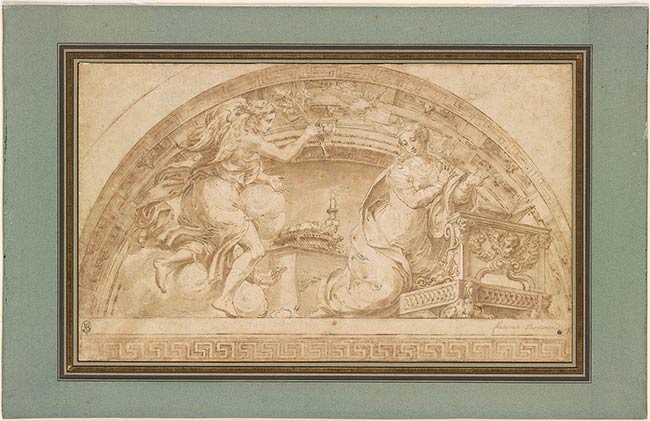
Born in Viadana in Lombardy, Bedoli moved to Parma, where he married a cousin of Parmigianino, born Francesco Mazzola. Bedoli’s first recorded commission, which came to him from the Confraternity of the Immaculate Conception in Parma, is the imposing altarpiece of the Immaculate Conception from 1533, now in the Galleria Nazionale in Parma. It was only after the premature death in 1540 of his famous cousin-in-law that Bedoli assumed the name of Mazzola, presumably because he wished to be seen as Parmigianino’s artistic heir. There is no evidence, however, that he ever received any training from the latter, or that the two ever worked together. Nonetheless, Bedoli’s paintings and drawings reveal him as Parmigianino’s closest follower and, indeed, patrons entrusted him with commissions left unfinished by Parmigianino, such as the one for the church of Santa Maria della Steccata.
Numbering about forty sheets, the corpus of Bedoli’s known drawings is relatively small. His work has usually been confused with that of Parmigianino, the present example included. From the time it was first recorded in the Crozat collection until 1964, when Popham convincingly argued the case for an attribution to Bedoli, the drawing was considered “one of the most exquisite pieces from the hand of this artist [i.e., Parmigianino] that one may come across,” to quote the catalogue of the 1775 Mariette sale. It is arguably one of Bedoli’s masterpieces, showing gracefully arranged figures within a perspectival architectural setting with meticulously drawn still-life details, such as the Virgin’s sewing basket placed next to a candlestick in the foreground and her richly engraved lectern. Finely brushed white heightening picks out the light falling on the angel and the Virgin and emanating from the Holy Ghost in the shape of a dove above. The high degree of finish and the inclusion of surrounding architectural detail, such as the meander frieze, suggest the study may well have been made in order to show the patron the design before it was implemented.
The composition must have been inspired by Correggio’s much simpler fresco of the same subject, originally painted in 1525 for the church of San Francesco just outside the city walls of Parma and now in the Galleria Nazionale, Parma.1 Correggio’s fresco was detached in 1546 when the church was demolished and moved to the new church of the Annunziata in Parma. The fact that both the Morgan drawing and the Correggio fresco are lunette-shaped led Popham to suggest that fear of damage to Correggio’s fresco during this move may have prompted a commission to Bedoli to paint a replacement. Nonetheless, while it is likely that the drawing dates to the 1540s or 1550s, Popham’s suggestion must remain hypothetical. The cassettone ceiling of the barrel-vaulted lunette resembles those in the church of Santa Maria della Steccata in Parma, where Bedoli decorated the north and south apses with frescoes of the Descent of the Holy Spirit and the Adoration of the Magi as well as the corresponding barrel vaults between 1547 and 1567.
Two paintings by Bedoli of an Annunciation survive—one in the Pinacoteca Ambrosiana, Milan, of ca. 1535– 40; the other, variously dated from the 1530s to 1550 on grounds of style, in the Museo di Capodimonte, Naples.2 There is also a preparatory drawing in the Kunsthalle, Hamburg, for the Ambrosiana painting.3 According to Popham, the Milanese and Neapolitan paintings predated the Morgan drawing.4
—REP
Footnotes:
- Galleria Nazionale, Parma. See Ekserdjian 1997, 145. For Correggio’s preparatory drawing, see Metropolitan Museum of Art, New York, inv. 19.76.9.
- Pinacoteca Ambrosiana, Milan, said to have originated in the church of San Francesco, Viadana; see Di Giampaolo 1997, no. 15. Museo di Capodimonte, said to have originated in the church of Santa Maria Annunziata, Viadana; see Di Giampaolo 1997, no. 23.
- Kunsthalle, Hamburg, inv. 52168; see Di Giampaolo 1997, no. 56.
- Popham 1964, 257.
Before entering Mariette's collection, this drawing belonged to Pierre Crozat (1665-1740), a wealthy banker who was a close friend and fellow collector. In the catalogue of the Crozat sale, compiled by Mariette himself, the sheet was described as a "capital drawing" by the celebrated Mannerist Parmigianino. Only in the twentieth century have scholars recognized in this work the hand of Girolamo Mazzola Bedoli, a painter whose reputation had been forgotten in Mariette's time but who was one of Parmigianino's most talented successors in sixteenth century Parma. -- Exhibition Label, from "Pierre-Jean Mariette and the Art of Collecting Drawings."
Inscribed at lower right, in pen and brown ink: "francesco Parmesan"; to the right of this, in darker ink: "3"; on verso, at lower edge, in graphite: "Vte[te superscript] Mariette No[o superscript] 504 300 livres"; on separate piece of paper pasted in lower right corner of verso, stamped in black ink and underlined in red ink: "278".
Watermark: Possibly letters "GH" with trefoil above on drawing, and stem with "grapes" at end (probably in lining?). Partly indecipherable because of lining.
Crozat, M. (Pierre), 1661-1740, former owner.
La Tour du Pin Gouvernet, Charles-Frédéric, marquis de, 1694-1775, former owner.
Mariette, Pierre-Jean, 1694-1774, former owner.
Destailleur, Hippolyte Alexandre Gabriel Walter, 1822-1893, former owner.
Beurdeley, Alfred, 1847-1919, former owner.
Rhoda Eitel-Porter and and John Marciari, Italian Renaissance Drawings at the Morgan Library & Museum, New York, 2019, no. 83.
Selected references: Popham 1964, no. 25; Copertini 1968, 125n2; Popham and Di Giampaolo 1971, no. 16; Di Giampaolo et al. 1979, no. 18; Di Giampaolo 1997, no. 118.

